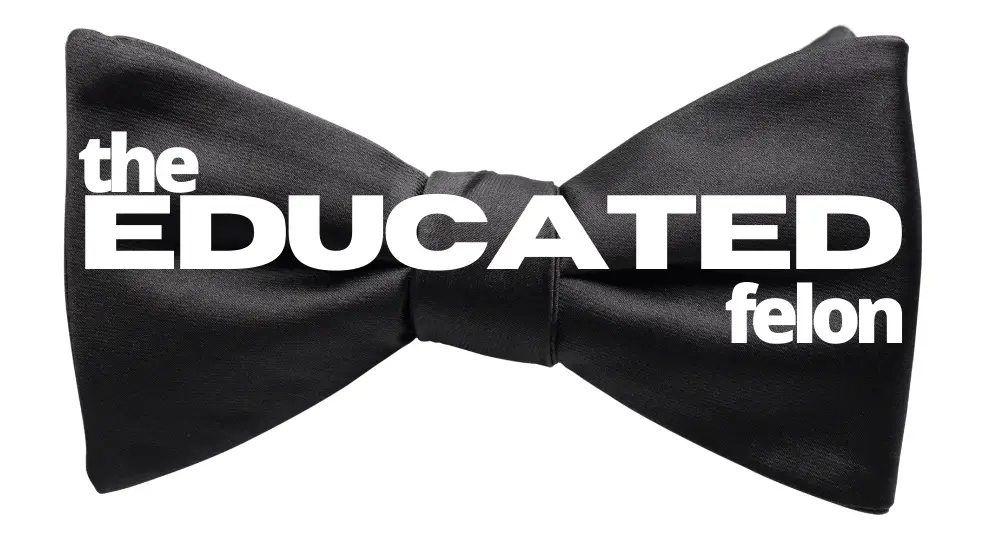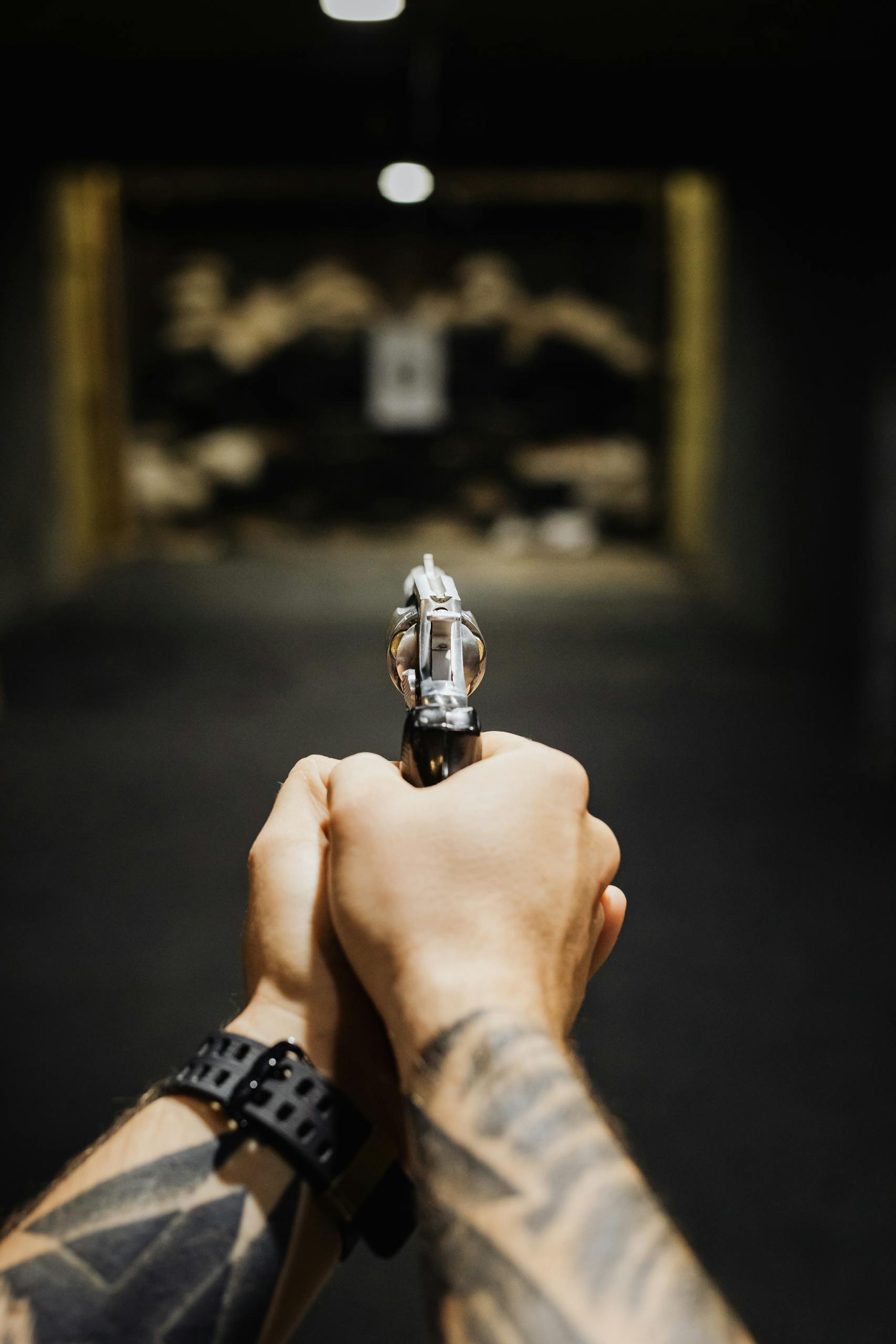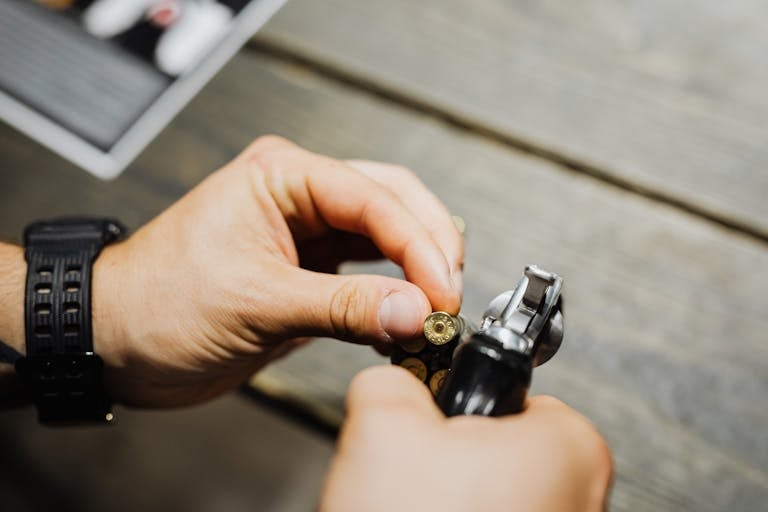Brandishing a Gun: What is It? (When Showing Off Your Piece Becomes a Felony)
Introduction
Ever wondered what exactly crosses the line between lawfully carrying a firearm and ending up in handcuffs? Welcome to the complicated world of “brandishing a gun” – the legal term that can turn a heated moment into a criminal charge faster than you can say “Second Amendment.”
Whether you’re a gun owner, a concerned citizen, or just someone who wants to understand why waving a pistol around isn’t the best way to win an argument, get ready. We’re about to dive deep into the legal quicksand of brandishing a firearm.
What Does “Brandish a Gun” Actually Mean?
The Legal Lowdown: More Than Just Flashing Steel
When we talk about brandishing a gun, we’re not discussing a fancy way to show off your new piece. Here’s the nitty-gritty:
- It typically means displaying a firearm in an intimidating or threatening manner
- The gun doesn’t have to be fired (that’s a whole other can of legal worms)
- Intent matters – accidental exposure usually doesn’t count
- It can apply to other deadly weapons too, but firearms get the spotlight
State-by-State: Brandishing Bingo Across America
Like a patchwork quilt of gun laws, each state has its take:
- California: Known for strict gun laws, brandishing here can be either a misdemeanor or felony
- Texas: Surprisingly, has no specific “brandishing” law, but it falls under disorderly conduct
- Florida: Calls it “improper exhibition” of firearms
- New York: Wraps it into menacing charges
- Virginia: Has a specific statute against “pointing, holding, or brandishing” firearms
Brandishing by the Numbers: Statistics That’ll Make You Holster That Attitude
Let’s crunch some numbers to see why brandishing is no joke:
- Approximately 30% of Americans own guns
- There are an estimated 393 million civilian-owned firearms in the U.S.
- About 1% of gun owners report a firearm was brandished for self-defense annually
- Brandishing incidents account for roughly 5% of aggravated assault charges
- 80% of brandishing cases involve handguns
- States with open carry laws see 20% more reported brandishing incidents
- Only 2% of brandishing cases result in the firearm being discharged
Real-Life Scenarios: When “Showing” Becomes a Federal “No-No”
- The Parking Lot Showdown: Joe gets into an argument over a parking space and lifts his shirt to reveal a holstered gun. Surprise! That’s brandishing.
- The Neighborly “Warning”: Sarah, fed up with loud music next door, waves her shotgun on her porch “to make a point.” Hello, brandishing charges!
- The Overenthusiastic Open Carry: Mike, exercising his open carry rights, adjusts his holster a bit too theatrically in a crowded store. Yep, could be brandishing.
- The Road Rage Regret: Tom, cut off in traffic, pulls alongside the other driver and holds up his pistol. Definite brandishing, and a possible felony.
- The Misunderstood Security Guard: Even professionals aren’t immune. A security guard unnecessarily drawing their weapon can face brandishing charges.
The Legal Fallout: Why Brandishing Is a Fast Track to Trouble
Brandishing a weapon isn’t just poor gun etiquette; it can have serious legal consequences:
- Misdemeanor charges in some states, felonies in others
- Potential prison time ranging from months to years
- Hefty fines, often in the thousands of dollars
- Loss of firearm rights
- A criminal record that can impact employment, housing, and more
Weapons of Choice: Popular Handguns in Brandishing Incidents
When it comes to brandishing a deadly weapon in a threatening manner, not all firearms are created equal. Some handguns appear more frequently in a brandishing case, often due to their popularity among gun owners. Let’s take a look at the firearms that most commonly make unwanted appearances:
- Glock 19:
- Compact and versatile
- Popular among both civilians and law enforcement (police officer)
- Frequently involved in brandishing due to its widespread ownership
- Smith & Wesson M&P Shield:
- Favored for concealed carry
- Its small size can lead to accidental exposure, resulting in brandishing charges
- Sig Sauer P365:
- Known for its high capacity in a small package
- Popular for everyday carry, increasing its presence in brandishing incidents
- Ruger LCP:
- Ultra-compact and easily concealable
- Sometimes brandished when owners feel overconfident due to its small size
- 1911-style pistols (various manufacturers):
- Classic design with a dedicated following
- Their larger size can make concealment challenging, leading to potential brandishing situations
Remember, it’s not the type of firearm that leads to brandishing charges, but how it’s used. Even a small .22 caliber pistol can result in serious legal consequences if brandished irresponsibly.
Key Takeaways:
- Compact and subcompact pistols are often involved due to their popularity for concealed carry
- Larger pistols can lead to brandishing charges through accidental exposure (directly visible)
- The specific model matters less than the handler’s actions and intent
Regardless of what firearm you own, responsible handling and a thorough understanding of local laws are crucial to avoiding brandishing charges.
When the Gun Comes Out: What You Should Do Instead
Proper firearm handling isn’t just about safety at the range; it’s about making wise decisions in potentially volatile situations. Here’s a comprehensive guide on what to do instead of brandishing a weapon in an aggressive manner:
- Keep Your Firearm Concealed Unless Absolutely Necessary
- If you’re carrying concealed, keep it that way
- Only draw your weapon if there’s an immediate threat to your life
- Remember, the element of surprise can be a tactical advantage in true self-defense situations
- Focus on De-escalation
- Use verbal communication to defuse tense situations
- Maintain a calm tone and non-threatening body language
- Avoid mentioning that you’re armed, as this can escalate the situation
- Create Distance and Find Cover
- If you feel threatened, your first move should be to increase the distance between you and the threat (the other persons)
- Look for physical barriers or cover that could protect you if the situation escalates
- Remember, your goal is to avoid conflict, not provoke it
- Be Prepared to Retreat
- Many states have “duty to retreat” laws before using force
- Even in “stand your ground” states, retreat is often the safest option
- Swallow your pride – it’s better to be alive than to “win” a confrontation
- Call Law Enforcement
- If you feel genuinely threatened, call 911 immediately
- Clearly describe the situation and your location
- Follow the dispatcher’s instructions
- Know Your State’s Laws
- Understand self-defense laws in your state
- Be aware of legal definitions of “brandishing” and “improper exhibition”
- Stay informed about where you can legally carry your firearm
- Attend Regular Training
- Participate in conflict resolution and de-escalation training
- Practice situational awareness to avoid potential conflicts
- Regularly brush up on firearm safety and legal use of force
- Use Alternative Self-Defense Tools
- Consider non-lethal alternatives like pepper spray for less serious threats
- These options can protect without the legal risks of deadly force
- Document Everything
- If you’re involved in an incident, write down everything that happened as soon as it’s safe to do so
- Collect contact information from any witnesses
- This information can be crucial if legal issues arise later
Remember, the presence of a firearm often escalates situations rather than resolves them. Your gun should be your absolute last resort, not your opening move in a conflict.
Test Your Knowledge: Brandishing a Gun True or False Quiz
Let’s see how well you understand the concept of brandishing and gun safety. Take this quick true or false quiz:
- Brandishing a gun always requires pointing it directly at someone.
- True
- False
- Accidentally exposing a concealed weapon can be considered brandishing.
- True
- False
- Brandishing laws are the same in every state.
- True
- False
- It’s legal to brandish a firearm if you feel threatened, even if there’s no immediate danger.
- True
- False
- Brandishing charges only apply to real firearms, not replicas or toy guns.
- True
- False
- You can brandish a gun on your property without legal consequences.
- True
- False
- Brandishing a firearm always results in felony charges.
- True
- False
- Open carry of a firearm is the same as brandishing.
- True
- False
How did you do? If you got all eight correct, congratulations – you’re well-informed about brandishing laws and gun safety.
If you missed a few, it might be time for a refresher on firearm laws and responsible gun ownership.
Remember, understanding these concepts isn’t just about passing a quiz; it’s about ensuring you use your firearm responsibly and legally, protecting yourself both physically and legally.
Legal Lifeline: When You Need a Pro in Your Corner
If you’ve made the mistake of brandishing a deadly weapon or are facing related charges, don’t try to shoot your way out of legal trouble.
A skilled criminal defense attorney can be the difference between a slap on the wrist and serious time. They’re like your personal legal bulletproof vest, protecting you from the full force of the law. Check out attorneys who know how to target the weak points in brandishing charges and help you aim for the best possible outcome.
Conclusion: Keep Your Gun Holstered and Your Record Clean
Brandishing a firearm might seem like a quick way to end an argument or feel powerful, but it’s a surefire path to legal trouble.
Remember, the only time your gun should make an appearance is at the range or in genuine self-defense situations (when your life is threatened with great bodily harm) – and even then, be absolutely sure you’re within your legal rights.
Stay informed, stay calm, and keep that firearm holstered. After all, the best gun owners are the ones you’d never know were carrying. Stay safe, stay legal, and be smart.







